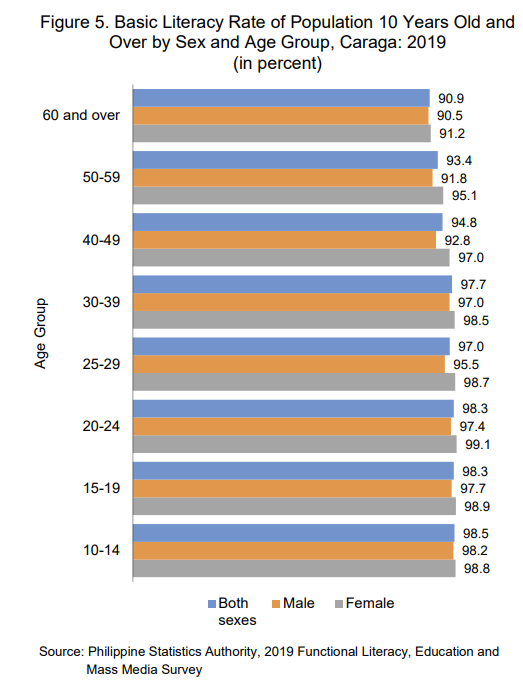
Ninety-four for every 100 population 5 years old and over are basic literate in 2019
In 2019, 93.6 percent or ninety-four for every 100 population five (5) years old and over in Caraga region were basic literate, according to the results of the 2019 Functional Literacy, Education and Mass Media Survey (FLEMMS). It is lower by 0.2 percentage point compared with the basic literacy rate of the country which was posted at 93.8 percent. (Figure 1 and Table 1)
Females posted higher basic literacy (94.8%) compared with males (92.5%). Similarly, females posted higher basic literacy (94.5%) than males (93.2%) at the national level. (Figure 1 and Table 1)

For every 100 population 10 years and over, 96 are basic literate
The basic literacy of population 10 years old and over in the region in 2019 was posted at 96.3 percent or 96 for every 100 persons. It is higher by 0.1 percentage point than the results in 2013 at 96.2 percent. The proportion of basic literate females (97.3%) remained higher than among their male counterparts (95.4%). (Figure 2 and Table 2)

Population five (5) years old and over in the region who had access to electricity were reported to have higher basic literacy (94.3%) than those without access (81.8 %). Likewise, those living in urban areas, with or without access to electricity, posted higher basic literacy rate than those in rural areas. (Figure 3 and Table 3)
Among urban dwellers in the region, 95.5 percent of the population 5 years old and over who had access to electricity were basic literate, higher that those without electricity at 85.3 percent. Consistently, in rural barangays of the region, those who had access to electricity were reported to have higher basic literacy (93.4%) than those without access to electricity (79.9 %). (Figure 3 and Table 3)

Among population five (5) years old and over, those who were at least junior high school level completer in the K-12 curriculum, or equivalently high school graduate in the old curriculum, had 100.0 percent or a very high basic literacy rate, while those with no grade completed or at most received early childhood education had the lowest recorded basic literacy rate at 43.6 percent. (Figure 4 and Table 4)'

Among the age groups of population 10 years old and over, the highest basic literacy rate was in the age group 10 to 14 years old at 98.5 percent. The lowest basic literacy rates was recorded in the age group 60 years old and over at 90.9 percent. (Figure 5 and Table 5)
Females posted higher basic literacy rates in all age groups compared with men. The highest basic literacy rate of females was in the age group 15 to 19 years old at 98.9 percent while the highest basic literacy rate of males was in the age group 10 to 14 years old at 98.2 percent. (Figure 5 and Table 5)


TECHNICAL NOTES
The 2019 Functional Literacy, Education and Mass Media Survey (FLEMMS) is the sixth in the series of functional literacy surveys conducted by the former National Statistics Office (NSO), now a part of the Philippine Statistics Authority (PSA). The five previous rounds were conducted in 1989, 1994, 2003, 2008 and 2013. The survey was conducted in line with the government’s thrust to promote education policies and programs aimed at eradicating illiteracy in the country.
The 2019 FLEMMS is designed to provide a quantitative framework that will serve as a basis in the formulation of policies and programs on the improvement of literacy and education status of the population. For 2019 FLEMMS, basic literacy rate of population 5 to 9 years old was also measured, 5 years old being the official school age in the K to 12 curriculum.
Definition of Terms
Basic or simple literacy - is the ability of a person to read and write with understanding of a simple message in any language or dialect. The basic literacy status of an individual was determined based on the respondent’s answer to the question “Can ______ read and write a simple message in any language or dialect?”
Highest educational attainment – refers to the highest grade or year completed in school, college, or university. This may be any one of the specific grades or years in elementary, high school, K to 12 Program, and college. It also includes preschool, special needs and second-chance education, postsecondary, shortcycle tertiary, college, and post baccalaureate courses.
Approved by:
(Sgd.)ROSALINDA C. APURA, DM
Regional Director, PSA-RSSO XIII
Telephone number: (085) 225-5219 / Telefax No. : (085) 815 – 4935
Email address: psacaraga_rsso13@yahoo.com.ph

